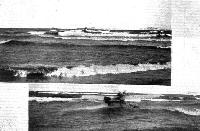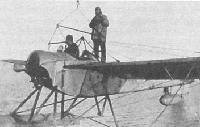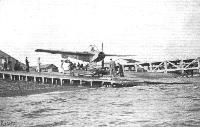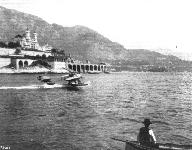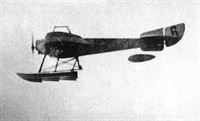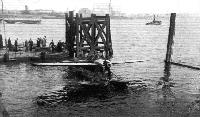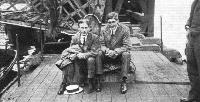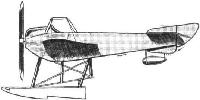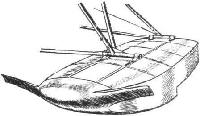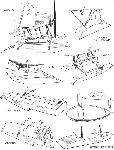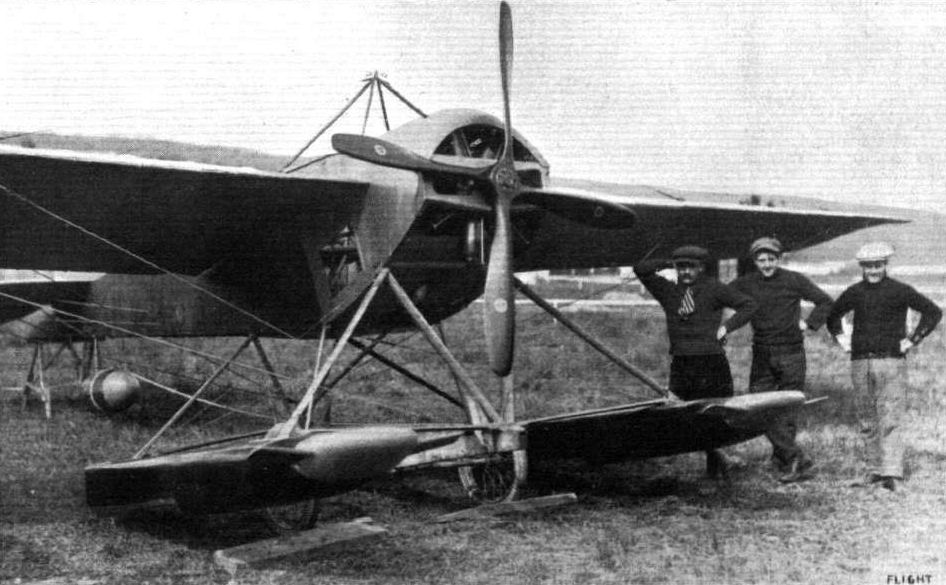
Описание
Страна: Франция
Год: 1912
Варианты
- Nieuport - Nieuport-II/III - 1910 - Франция
- Chanter - monoplane - 1911 - Великобритания
- Nieuport - Nieuport-IV - 1911 - Франция
- Nieuport - Nieuport-IV Hydro / Nieuport-VI - 1912 - Франция
- Дыбовский В.В. - Ньюпор - 1913 - Россия
- Нестеров П.Н. - Ньюпор - 1914 - Россия
- D.James Schneider Trophy Aircraft 1913-1931 (Putnam)
- J.Davilla, A.Soltan French Aircraft of the First World War (Flying Machines)
- L.Opdyke French Aeroplanes Before the Great War (Schiffer)
- O.Thetford British Naval Aircraft since 1912 (Putnam)
- Jane's All The World Aircraft 1913
- J.Forsgren Swedish Military Aircraft 1911-1926 (A Centennial Perspective on Great War Airplanes 68)
- Журнал Flight
-
J.Davilla, A.Soltan - French Aircraft of the First World War /Flying Machines/
Nieuport 6H of the Aviation Maritime.
-
D.Mechin - Oriental Adventures of the French Air force 1914-1918 /Aeronaut/
Nieuport XH "N11" flew from December 1914 to January 1916. It was equipped with a 80 hp Rhone engine.
-
D.Mechin - Oriental Adventures of the French Air force 1914-1918 /Aeronaut/
Nieuport N 13 was lost during a reconnaissance flight to the Dead Sea, crashing near Yotveta after engine problems. The heroic crew, QM Herve Le Gall and British observer, Captain Walter Francis Sterling, managed to return by foot to their supporting ship Minerva stationed in the Aqaba Gulf despite Turkish patrols.
-
D.Mechin - Oriental Adventures of the French Air force 1914-1918 /Aeronaut/
Nieuport seaplane N 14 with 80 Le Rhone engine, flown by Matelot Levasseur, Antivari (Montenegro), October 18, 1914. (David Mechin)
-
D.Mechin - Oriental Adventures of the French Air force 1914-1918 /Aeronaut/
Nieuport XH "N16" with 80 hp Clerget engine had a long career of 16 months of flights in Port-Said, and at least one overhaul as shown in the two profiles above & below.
-
D.Mechin - Oriental Adventures of the French Air force 1914-1918 /Aeronaut/
Nieuport XH "N 18" with 80 hp Clerget engine flew from March 1915 to April 1916 in Port-Said.
-
D.Mechin - Oriental Adventures of the French Air force 1914-1918 /Aeronaut/
Profile of a Nieuport seaplane of the Argostoli Naval Aviation Center coded N 19. Very resistant, these aircraft produced in 1914 were only withdrawn from service at the beginning of 1917.
-
D.Mechin - Oriental Adventures of the French Air force 1914-1918 /Aeronaut/
Nieuport monoplane with 80 hp Clerget engine, CAM Argostoli, Summer 1916.
-
D.Mechin - Foreign Fronts of the French Air Force 1914-1919 /Aeronaut/
Nieuport XH "NB1" with 100 hp Clerget engine began its career in Brindisi, then came in March 1916 to Port-Said and finished its career in Argostoli.
-
D.Mechin - Foreign Fronts of the French Air Force 1914-1919 /Aeronaut/
Nieuport hydro NB2 Type X Clerget 100 hp
-
D.Mechin - Foreign Fronts of the French Air Force 1914-1919 /Aeronaut/
Profile of the Nieuport seaplane of the Escadrille de Brindisi, equipped with a 100 hp Clerget engine.
-
Журнал - Flight за 1912 г.
The latest Nieuport hydro-aeroplane, which is being put through experiments at Meuian under the direction of Lieut. Delage. Note the special construction of the front floats and the tall-sustaining float.
-
Журнал - Flight за 1914 г.
Nose and chassis of Nieuport hydro.
-
J.Forsgren - Swedish Military Aircraft 1911-1926 /Centennial Perspective/ (68)
The Nieuport IVm at the Stockholm naval yard, presumably in late 1913. Via Arlanda Flygsamlingar
-
Журнал - Flight за 1914 г.
The Nieuport stand.
-
Журнал - Flight за 1913 г.
THE PARIS-DEAUVILLE WATERPLANE RACE. - General scene at the start from Paris.
Другие самолёты на фотографии: Donnet-Leveque Type A/B/C - Франция - 1912
-
Журнал - Flight за 1914 г.
A REMINISCENCE OF THE MONACO AERIAL RALLY. - A couple of snaps during the competition of M. A. Mallard on his Nieuport waterplane at Marselles.
-
Журнал - Flight за 1915 г.
UNSHIPPING AN 80 H.P. NIEUPORT SEAPLANE AT PORT SAID. - 1. General Maxwell and Admiral Pielse watching the operations from ashore. 2, 3 and 4. In process of swinging the Nieuport from the cruiser "Doris." 5. At rest on the sea. 6. Getting away.
-
J.Davilla, A.Soltan - French Aircraft of the First World War /Flying Machines/
Nieuport 6H being loaded on board the SS Rabenfels (a captured German merchant vessel) in late April 1915.
-
D.Mechin - Oriental Adventures of the French Air force 1914-1918 /Aeronaut/
Nieuport seaplane being put to water from the French seaplane carrier Foudre. (Author's collection)
-
J.Davilla, A.Soltan - French Aircraft of the First World War /Flying Machines/
Nieuport 6H being hoisted onboard ship.
-
D.Mechin - Oriental Adventures of the French Air force 1914-1918 /Aeronaut/
The type X H N11 had a long career in the Port Said escadrille, visiting the coasts of Palestine, Lebanon, and Turkish Cilicia. It sank off the Sinai on December 4,1915, its crew (QM Grail and 2nd Lt H.M.C. Ledger) managing to swim to shore. The wreckage was recovered and used as a spare parts store. (Coll ARDHAN via Robert Feuilloy)
-
D.Mechin - Oriental Adventures of the French Air force 1914-1918 /Aeronaut/
The N13 crashed in the south of Palestine on December 31, 1914, 30 km from the Gulf of Aqaba where its ship, Minerva, was waiting. Its heroic crew, composed of QM Grail and Cpt Stirling, managed to escape the Turkish patrols on foot in the desert. (Coll ARDHAN via Robert Feuilloy)
-
D.Mechin - Oriental Adventures of the French Air force 1914-1918 /Aeronaut/
The Nieuport serial N 14 found empty by a British ship on 28-01-1915. The crew, QM Le Gall and Lt Partridge, had to abandon it due to an engine problem, and came back to the British lines in Suez on foot, but were shot down by mistake by the Gurkhas.
-
D.Mechin - Oriental Adventures of the French Air force 1914-1918 /Aeronaut/
In Port-Said, the Nieuport X H N.14 undergoing a stowage test on the cargo ship La Lorraine of the Compagnie Generale des Transports in April 1915. A veteran of the Montenegro expedition, N.14 was convoyed to Port Said on the Foudre on 30 November 1914. It ended up in the desert on 10 October 1915 near Beersheba, its crew being captured. (Coll ARDHAN via Robert Feuilloy)
-
D.Mechin - Oriental Adventures of the French Air force 1914-1918 /Aeronaut/
Nieuport N.16 ready to go for a mission. (Coll ARDHAN via Robert Feuilloy)
-
D.Mechin - Oriental Adventures of the French Air force 1914-1918 /Aeronaut/
Nieuport monoplane N 16 in Centre d'Aviation Maritime de Port-Said, on the shore of Suez Canal. (Collection ARDHAN)
-
J.Davilla, A.Soltan - French Aircraft of the First World War /Flying Machines/
Nieuport 6H serial N16 of the Escadrille Nieuport of the Aviation Maritime at Port Said in April 1915.
-
D.Mechin - Oriental Adventures of the French Air force 1914-1918 /Aeronaut/
View of same N.16 recovered after an accident. The aircraft will fly again... We note a different inscription "N16" compared to the previous picture, testimony that Nieuport seaplanes were regularly overhauled and recovered by the mechanics of Port-Said. (Coll ARDHAN via Robert Feuilloy)
-
D.Mechin - Oriental Adventures of the French Air force 1914-1918 /Aeronaut/
At the end of June 1915, LV Cintre (left) and 2nd Lt H.G. Hillas, a British observer, made leaflet drops in Nieuport N.18 from the Hardinge transport on the Arabian coast of the Red Sea, flying over Jeddah on June 30th. The picture was taken five days later. (Coll ARDHAN via Robert Feuilloy).
-
D.Mechin - Oriental Adventures of the French Air force 1914-1918 /Aeronaut/
Nothing was lost in maritime aviation: after the dissolution of the Brindisi squadron (Italy) in January 1916, the NB 1 and NB 2 served on the deck of the cargo ship Anne in the Red Sea, as early as February 1916. NB 1 sank on March 13th; NB 2 was brought to Argostoli in June after the dissolution of the Port Said CAM. (Coll. Colin Owers)
-
D.Mechin - Foreign Fronts of the French Air Force 1914-1919 /Aeronaut/
The Nieuport NB2, taken out of its hangar and launched in the port of Brindisi from where it flew for a maritime patrol. (ARDHAN)
-
D.Mechin - Foreign Fronts of the French Air Force 1914-1919 /Aeronaut/
View of the Nieuport coded "NB 3"of the Brindisi squadron, which carried out maritime patrols south of the Italian boot from September 1915 to January 1916. It was equipped with three Nieuport seaplanes and a prototype Caudron seaplane (Paolo Varriale).
-
D.Mechin - Oriental Adventures of the French Air force 1914-1918 /Aeronaut/
Nieuport seaplane launched at the Naval Aviation Center (CAM) of Argostoli, created in May 1916. (Coll. ARDHAN)
-
Журнал - Flight за 1914 г.
AT THE FREJUS NAVAL AIR STATION. - Launching a Nieuport waterplane. The method adopted is to warp it out to an anchored buoy about 100 yards from thi shore; the cradle on which it travels on land is then unlashed and sinks, to be drawn in shore later, the pilot starting the engine himself from the seat.
-
L.Opdyke - French Aeroplanes Before the Great War /Schiffer/
The Nieuport VI tandem seaplane.
-
D.Mechin - Oriental Adventures of the French Air force 1914-1918 /Aeronaut/
One of the Nieuport monoplane of the CAM Argostoli, veteran of the CAM Port Said (ARDHAN)
-
Журнал - Flight за 1913 г.
The Nieuport hydro-monoplane showing its paces at Monaco during the recent meeting.
-
D.James - Schneider Trophy Aircraft 1913-1931 /Putnam/
Most of the Nieuport’s design features are visible in this view of Espanet’s aircraft at Monaco in 1913.
-
L.Opdyke - French Aeroplanes Before the Great War /Schiffer/
The Nieuport IVG hydro.
-
Журнал - Flight за 1914 г.
A Nieuport hydro-aeroplane in full flight.
-
Журнал - Flight за 1914 г.
Seaplane flying at St. Raphael, the French Mediterranean aviation station. - Levasseur flying a Nieuport.
-
J.Davilla, A.Soltan - French Aircraft of the First World War /Flying Machines/
Nieuport 6H of the 1st Escadrille in flight. Via Alan Durkota.
-
D.James - Schneider Trophy Aircraft 1913-1931 /Putnam/
A fast taxi-ing Nieuport seen with a large amount of starboard mainplane warp applied.
-
Журнал - Flight за 1913 г.
M. LEVASSEUR'S NIEUPORT "IN CUSTODY" AT THE THAMES POLICE STATION, BLACKWALL. - On the pier are the pilot, M. Levasseur, his passenger, M. Rougerie, Mr. Harold E. Perrio, Secretary of the Royal Aero Club, &c.
-
Журнал - Flight за 1913 г.
M, Levasseur (on the right), and his passenger, M. Rougerie, on the pier of the Thames Police Station at Blackwall, cogitating over their fate for having infringed the British air regulations.
-
Журнал - Flight за 1914 г.
Tall planes and float of Nieuport hydro.
-
Журнал - Flight за 1912 г.
The 100-h.p. Nieuport hydro-monoplane.
-
Jane's All The World Aircraft 1913 /Jane's/
NIEUPORT. Hydro. By favour of "Flight." UAS.
-
Журнал - Flight за 1913 г.
The 100-h.p. Nieuport hydro-monoplane.
-
Журнал - Flight за 1914 г.
The 100 h.p. Nieuport seaplane.
-
Журнал - Flight за 1913 г.
The tail of the 100-h.p. Nieuport Hydravion.
-
Журнал - Flight за 1913 г.
Details of the front of the Nieuport float, showing the peculiar fin-like projections in front which prevent the float from burying itself in rough water.
-
Журнал - Flight за 1913 г.
Side elevation of the Nieuport float.
-
Журнал - Flight за 1914 г.
View from underneath of one of the Nieuport floats.
-
Журнал - Flight за 1913 г.
Attachment of main floats (on right) and (on left) the tail float on the Nieuport hydro-aeroplane which was at the last Olympia Show. The machines at Monaco have a three stepped keel float.
-
Журнал - Flight за 1914 г.
ATTACHMENT OF FLOAT TO CHASSIS ON NIEUPORT HYDRO. - On right upper pylon.
-
Журнал - Flight за 1913 г.
HYDRO-AEROPLANES. - Fig. 5. - Types of Aeroplanes.
Другие самолёты на фотографии: Astra Type C - Франция - 1911Borel hydro-monoplane - Франция - 1912Curtiss A - США - 1911Curtiss F/K - США - 1913Deperdussin hydro-monoplane - Франция - 1912Donnet-Leveque Type A/B/C - Франция - 1912Fabre Hydravion - Франция - 1910Farman HF.14 / HF.23 - Франция - 1912REP hydro-monoplane - Франция - 1912Sanchez-Besa biplane, hydro-biplane - Франция - 1911Voisin Canard - Франция - 1911
-
Журнал - Flight за 1912 г.
Some of the types of float used on present-day hydro-aeroplanes, as seen at the Paris Aero Salon.
Другие самолёты на фотографии: Borel hydro-monoplane - Франция - 1912Caudron pusher seaplane - Франция - 1912Farman HF.14 / HF.23 - Франция - 1912Goupy floatplane - Франция - 1912REP hydro-monoplane - Франция - 1912
-
Журнал - Flight за 1913 г.
A study in tails.
Другие самолёты на фотографии: Bleriot Bleriot-XI-2 - Франция - 1911Breguet 3 - Франция - 1910Bristol Coanda monoplane - Великобритания - 1912Deperdussin Racer - Франция - 1912Handley Page Type E / H.P.5 - Великобритания - 1912RAF B.E.2/B.E.2a/B.E.2b - Великобритания - 1912Sopwith Bat Boat - Великобритания - 1913Sopwith Three-Seater - Великобритания - 1913Vickers EFB.1 - Великобритания - 1913
-
Журнал - Flight за 1916 г.
Various engine mountings and housings.
Другие самолёты на фотографии: Bristol Baby (Scout) - Великобритания - 1914Bristol TB.8 / GB.75 - Великобритания - 1913Dyott monoplane - Великобритания - 1913Grahame-White Lizzie - Великобритания - 1913Morane-Saulnier G/H - Франция - 1912Vickers tractor scout - Великобритания - 1914
D.James Schneider Trophy Aircraft 1913-1931 (Putnam)
Nieuport
During the First World War Nieuport fighters were widely used by the Allies in France and even more widely known elsewhere. Yet the name, Nieuport, cloaked the identity - if rather thinly - of a young man who had moved to France from Algeria and who, in 1908, had designed and built a handsome 20 hp Darracq-engined monoplane in which he had achieved a measure of streamlining by covering the wooden girder structure of the fuselage with fabric. In addition to the airframe, this accomplished engineer built the engine, a number of its components and the propeller.
During the next three years he became well known in French aviation circles and it was this fame, which his family regarded as notoriety, which caused him to change his name from Edouard de Nieport to Nieuport. Such was the regard which his family had for the new field of aviation.
When Nieuport and his brother Charles were killed in air accidents - Edouard on 6 September, 1911, and Charles two years later - that great industrialist and patron and benefactor of French aviation, Henri Deutsch de la Meurthe, acquired and continued the Nieuports’ business interests, creating a limited company named Societe des Etablissements Nieuport. This new company was based at Issy-les-Moulineaux, near Paris. Following a subsequent merger and managerial changes in 1921, the company achieved continuing fame with racing aircraft under the name Nieuport-Delage.
Two years before the first Schneider Trophy contest and with some three years’ experience of Nieuport’s designing, building and flying his own aeroplanes, a Nieuport monoplane, powered by a 100 hp Gnome seven-cylinder air-cooled rotary engine, and claimed to have an 80mph top speed, had won the third Gordon Bennett Aviation Cup race at Eastchurch, Isle of Sheppey. With a United States pilot, Charles Weymann, at the controls, the 8-38 m (27 ft 6 in) span racer completed the 25-lap 93 1/4 mile race at an average speed of 78mph. Nieuports also took third and fifth places in this race.
For the 1913 Schneider contest the Nieuport company produced a sleek monoplane with a marked resemblance to the Gordon Bennett winner but about half as big again and twice the weight. The rectangular-section rear fuselage was built up from spruce longerons with spruce frames which were all wire-braced with piano wire. Control cables to the tail unit passed through wood-framed apertures in the flat sides of the fuselage. The top and sides of the Gnome engine were enclosed in an aluminium cowl, and the curved top decking in front of the open cockpit and the floor were of plywood. Varnished fabric covered the remainder of the fuselage. A raised lip around the cockpit was leather bound. The two spars of the markedly cambered aerofoil section wing were of spruce, with spruce leading- and trailing-edge strips, and ash ribs. Fabric covering was also applied to the wings. Control and bracing wires passed from a four-leg wooden cabane to the front and rear spars and down to the two main floats. The large curved butterfly-shaped tailplane and elevator unit was mounted on top of the rear fuselage. The tailplane was a cantilever all-wood fabric-covered structure, as were the dorsal and ventral fins. The elevators and the rudder were of similar all-wood fabric-covered construction. The alighting gear comprised four main float-mounting struts of wood with special wire-braced shock-resisting struts attached to the underside of the fuselage and to the forward of the pair of float spreader bars. Duralumin tips were fitted to the flat-sided hard chine wooden floats which initially had slightly rounded top surfaces, a single step half-way along their length and a deep vertical transom. Before the contest, in order to improve the take-off characteristics, floats with a three-step 31-75cm (124 in) wide keel, giving a saw-tooth effect, were fitted to Weymann’s Nieuport. A circular-section ‘tear-drop’ shaped stabilizing float was mounted on unbraced struts under the rear fuselage.
Single/two-seat twin-float racing monoplane. Wooden construction with fabric covering. Pilot and one crew in tandem in open unfaired cockpit.
1913 - one 100 hp Gnome seven-cylinder air-cooled rotary engine driving a two-blade fixed-pitch wooden propeller; 1914 - one 160 hp Gnome fourteen-cylinder twin-row aircooled rotary engine driving a 2-3 m (7 ft 6 in) diameter two-blade fixed-pitch wooden propeller.
Span 11-88m (38ft 11 1/2in); length 8-7m (28ft 7in); height 2-8m (9ft 3in); float length 3-58 m (11 ft 9 in); maximum wing chord 1-88 m (6 ft 2 in).
Empty weight 600 kg (1,323lb); loaded weight 850 kg (1,874lb).
Maximum speed 115-87 km/h (72mph).
Production - about six seaplane racers built during 1912-14.
Colour - 1913 contest. Believed overall yellow with black contest number.
Описание:


















